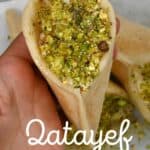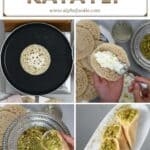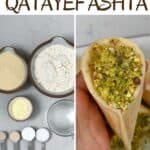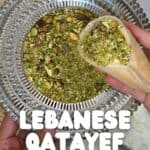This post may contain affiliate links. Please read our disclosure policy.
How to make Qatayef two ways: filled pancakes with a sweetened cream (ashta) or nut filling and then shaped into a cone and doused in syrup or sealed and fried until crisp! This popular Ramadan dessert is simple to prepare and can even be made dairy-free!
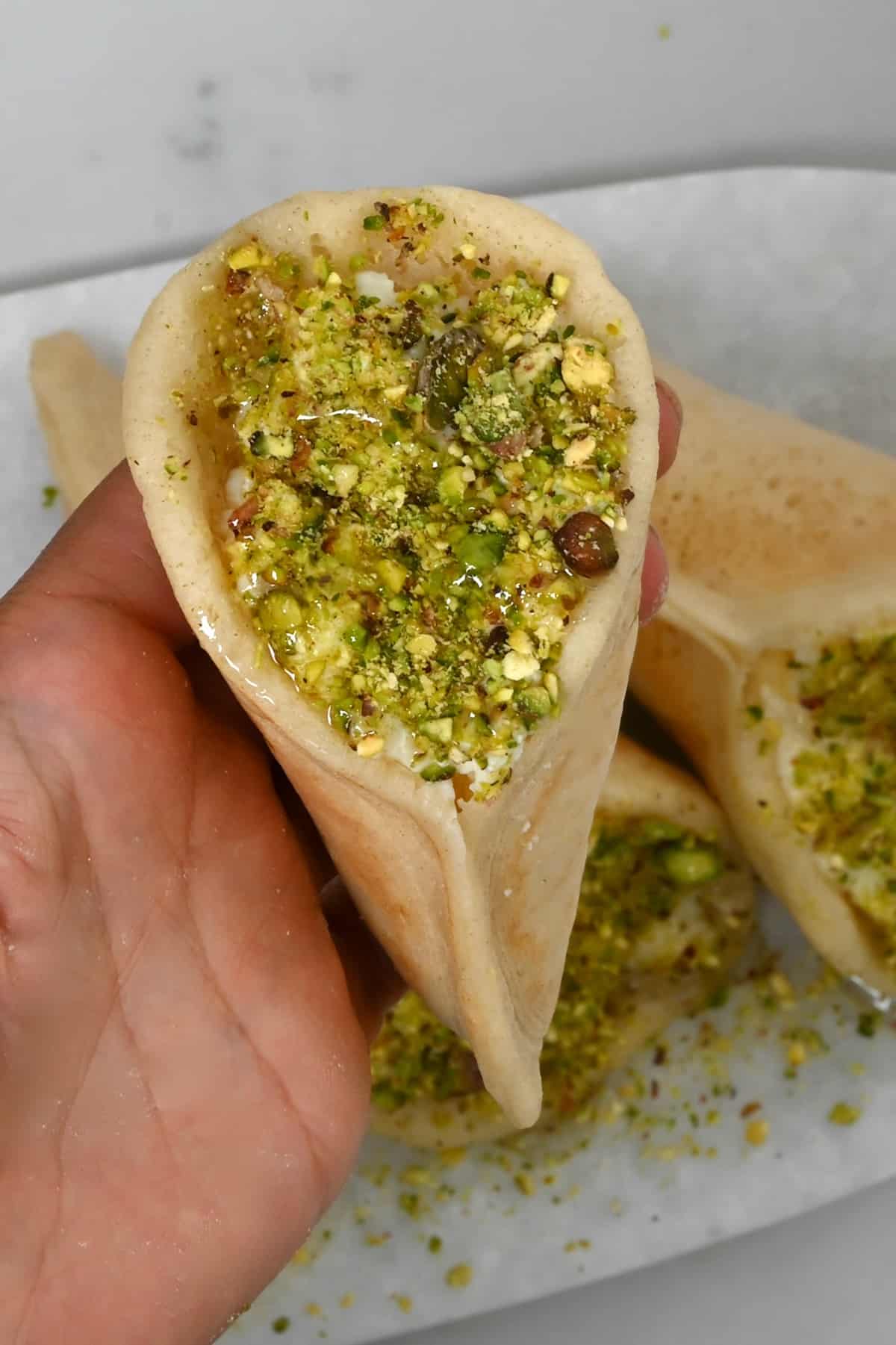
Want to save this recipe?
What is Qatayef?
Qatayef – also referred to as katayef or atayef – is an Arabic sweet popularly served as a Ramadan dessert (along with kunafa). While it technically refers to the dumpling/pancake batter only, the full dessert consists of small semolina-yeast pancakes, usually filled with a sweetened cream (Ashta) or cinnamon-nut filling. They are then either pinched together into a cone shape (qatayef asafari) or sealed entirely and fried (or baked) until crispy.
If you’re based in a Middle-Eastern country, you may have noticed the qatayef dough sold ready-made as Ramadan approaches. However, for the rest of the world, it’s tricky (if impossible) to find – and the same goes for ashta (which is available year-round in many countries, including Lebanon). Luckily, the process of making these mini filled pancakes is surprisingly simple – you don’t even have to flip the pancakes!
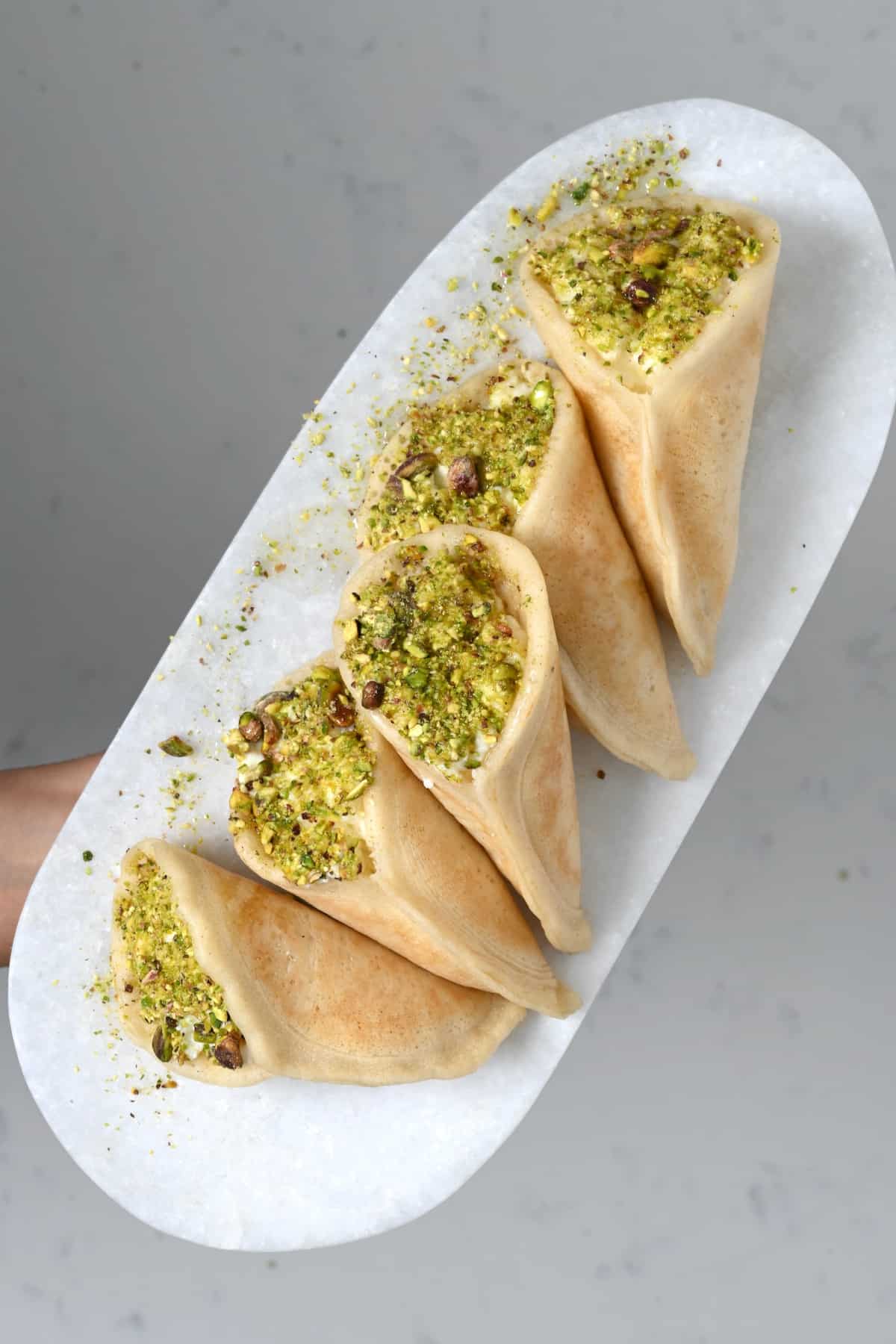
Within this post, I’ll be taking you through how to make both versions, with homemade ashta (atayef ashta) and simple syrup. No matter which you choose, the results are sweet, sticky, delicious, and make for the most indulgent cream cheese stuffed pancakes you’ll ever try! If you make the fried version, you even get to enjoy a crisp, crunchy outer shell – yummy!
The Qatayef (Filled Pancakes) Ingredients
The Pancake Dough
- Flour: this qatayef recipe requires all-purpose flour. I haven’t tried it with a gluten free AP blend, though it may work.
- Semolina: make sure to use fine semolina.
- Powdered milk: you can use homemade powdered milk OR store-bought. For a dairy-free option, use powdered soy milk/coconut milk. If you don’t have powdered milk, you can use ¾ cup warm milk in place of some of the warm water in the recipe.
- Water: make sure the water is lukewarm (not too hot, or it will kill the yeast).
- Dry Yeast: you need “instant” yeast for this recipe. Any other kind won’t work.
- Baking Powder: will help to give the pancakes their signature bubbly texture.
- Mahlab powder: if you’re unable to source it, you can omit it. Mahlab helps to enhance the sweet flavor of this Ramadan dessert, but isn’t necessary.
- Sugar: (optional) you can use regular sugar, unrefined sugar, or a sugar-free sweetener like erythritol/ xylitol, etc. Just be aware how the flavor and sweetness will change to adjust the amount accordingly.
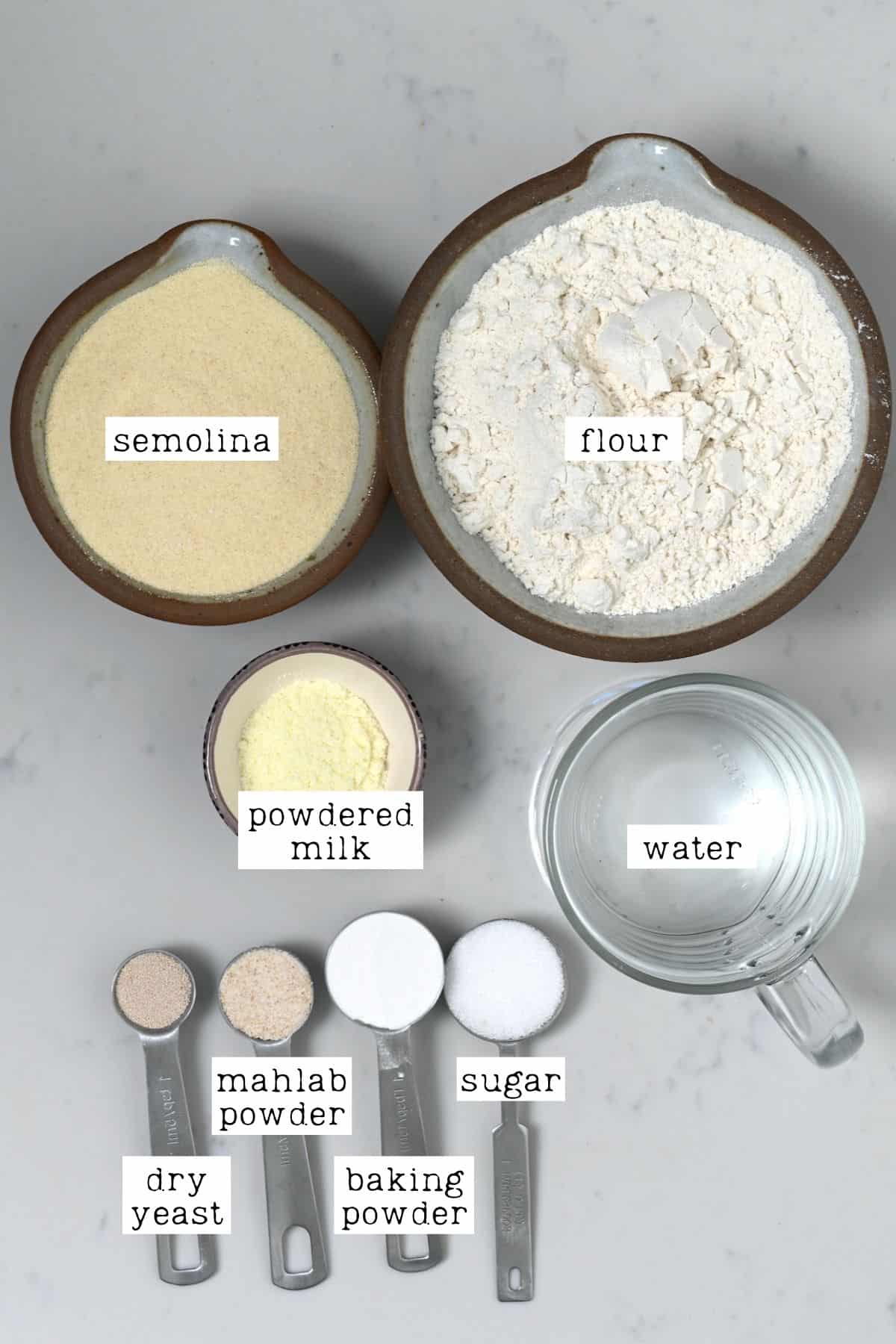
Fillings
- Ashta: I used homemade ashta (a sweet cream/cheese) delicately scented with rose water and orange blossom water to make atayef ashta.
- Simple syrup: I used homemade simple syrup using a 2:1 ratio of sugar to water and a squeeze of lemon juice. Store-bought will work fine too. Regular sugar is traditional, but feel free to use an unrefined sugar (or sweetener) to make the syrup, if preferred.
- Pistachios: crushed pistachios are used as a typical garnish to the katayef.
- Oil: if you want to make the fried version, you’ll need a neutral frying oil – like vegetable oil.
Optional Add-ins & Recipe Variations
- Flavored ashta: the simplest way to add extra flavor to the qatayef recipe is with flavored ashta (or syrup). Check out this ashta recipe post for several options (vanilla, cocoa, etc.)
- Walnut filling: for a dairy-free filling, you can combine chopped walnuts (or another nut like hazelnuts, almonds, pistachios, etc.) with cinnamon (and optionally a tiny pinch of cardamom) and a little simple syrup lightly scented with rose water (or powdered sugar). Optionally you can add raisins too.
- Melty Cheese Filling: you could also use akawi cheese to fill the qatayef. Just make sure to soak it for several hours (3-4 at least) in ice cold water first, to de-salt it. Drain/squeeze the water out before using.
- Coconut flakes: you can use coconut flakes to sprinkle the katayef instead of pistachios, for a nut-free treat (when making the atayef bil ashta).
How to Make Qatayef
First, ensure that your simple syrup and ashta filling are prepared in advance. For the syrup, use a 2:1 ratio of sugar to water with a splash of lemon juice. Simmer for around 8 minutes until the syrup thickens into a more “syrupy” consistency.
Step 1: Prepare the Atayef Batter
- In a small bowl, combine the baking soda with ½ cup of lukewarm water and stir until the baking soda dissolves. Then set aside.
- Next, pour three cups of lukewarm water into a blender along with the remaining qatayef pancake ingredients (not the baking soda mixture). Blend well and then leave it to rest for 15 minutes (up to 45 minutes).
- Once rested, add the baking soda mixture, pulse a few times to mix (just for 4-5 seconds otherwise the batter will need to rest once more).
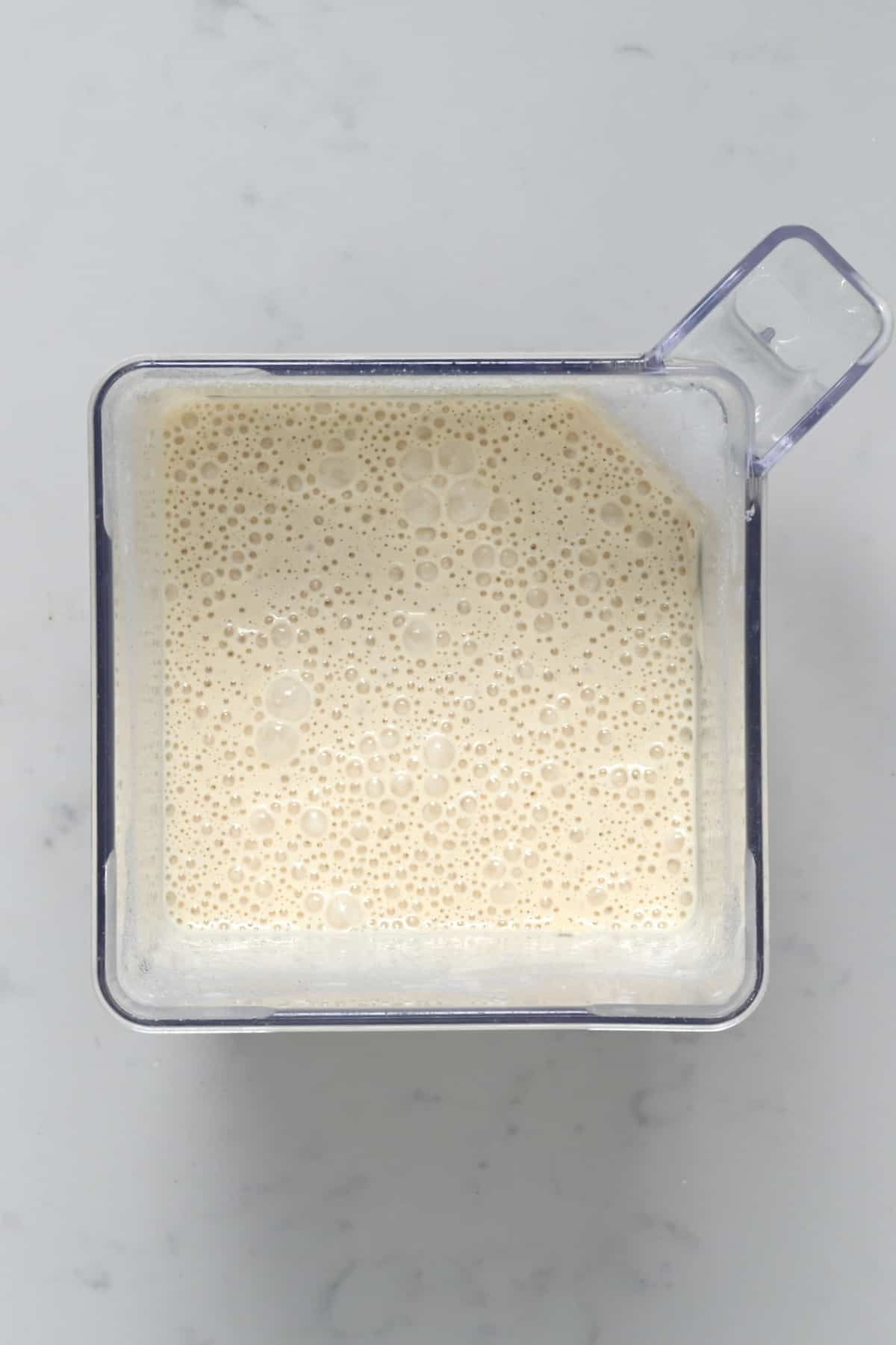
Step 2: Cook the “Pancakes”
- Heat a large non-stick skillet or griddle over medium heat until hot.
- Use around two tablespoons of batter (a small ice-cream/cookie scoop) per atayef and then add as many as possible to your skillet. While cooking, the pancakes will bubble up a lot (like crumpets). When the top of the pancake appears dry, it’s ready to remove them from the heat (no need to flip or it will dry out). If, in this time, the pancakes have burnt on the bottom, then simply reduce the heat slightly. Likewise, if they’re super pale on the bottom, increase the heat slightly (I recommend doing a test pancake first).
Adjust the amount of batter used based on how big you want the atayef to be. Once cooked, place the qatayef (bubbly side up) on a plate under a clean towel (or plastic wrap) while you make the remainder of the pancakes. Don’t stack them up, or they’ll stick.
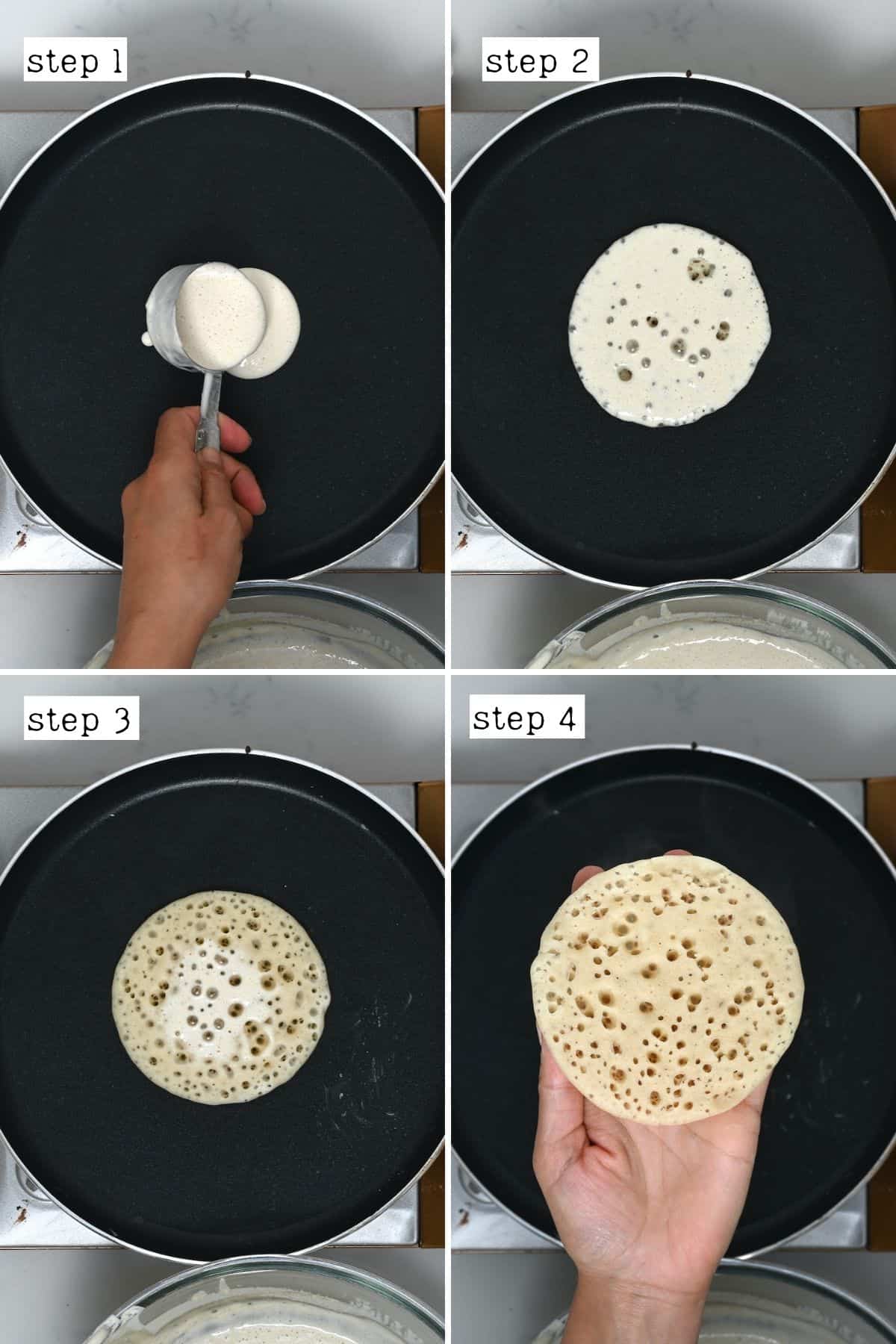
- Repeat the above with the remaining batter, until you’ve used it all.
Step 3: Fill the Qatayef
- With the bubbly side up, fill each pancake center with 1-2 tablespoons of kashta (or the nut mixture). This will vary if you change the size of the pancakes. It needs to be enough to seal the pancake without it tearing.
- Then it’s time to seal the qatayef in one of two ways:
– Qatayef asafiri: once filled, simply pinch the edges of the pancake together half-way, to form a cone shape, with the cream peaking out. Top up with a little extra ashta if preferred. Then either dip or sprinkle the exposed cream with the ground pistachios and drizzle with the simple syrup – enjoy!
– Fried qatayef: pinch the edges of the atayef together until fully sealed.
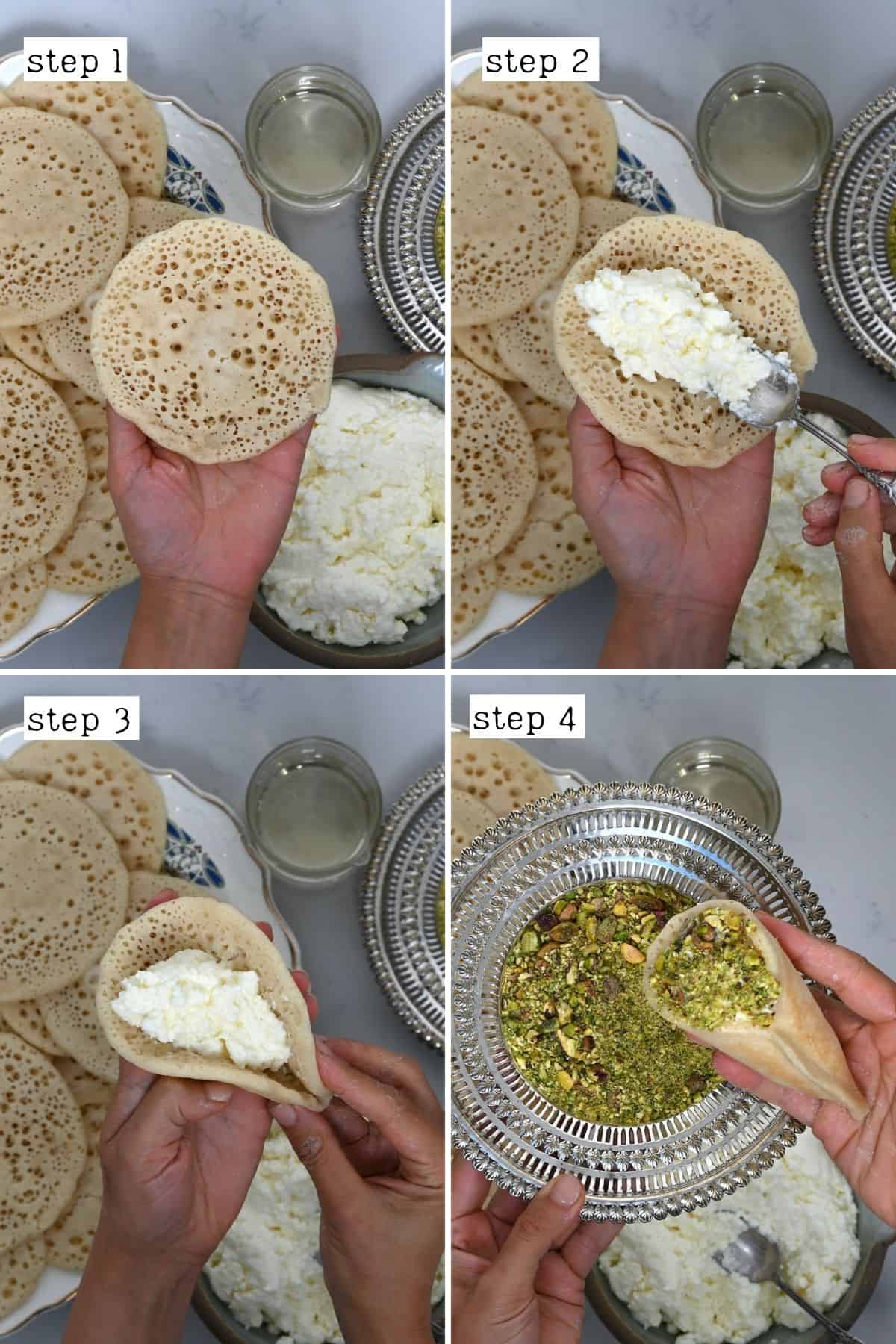
OPTIONAL Step 4: Fry the Qatayef
- In a wide, deep skillet, add enough oil to be around 1 ½-2 inches deep. Then, heat over medium heat until a chopstick/skewer dipped into the oil starts to form bubbles around it immediately (around 350ºF/175ºC if you have a thermometer).
- Then place the sealed qatayef in the oil – a few at a time (you don’t want to pack the pan, or it will cause the oil to lose heat) – and fry, flipping halfway, until a deep golden brown color (around two minutes).
Adjust how golden brown the qatayef are based on how crisp you want them to be.
- When removing the qatayef from the pan, transfer them to a layer of paper towels to drain any excess oil. Then, you can either drizzle the filled pancakes with the thick sugar syrup OR transfer them to a bowl with the syrup until thoroughly coated. After coating, transfer the filled pancakes to a rack with some parchment paper/foil beneath to drip off the excess syrup. Then, they’re ready to serve! You can optionally serve the qatayef with extra sugar syrup “dipping sauce” or orange blossom petal jam.
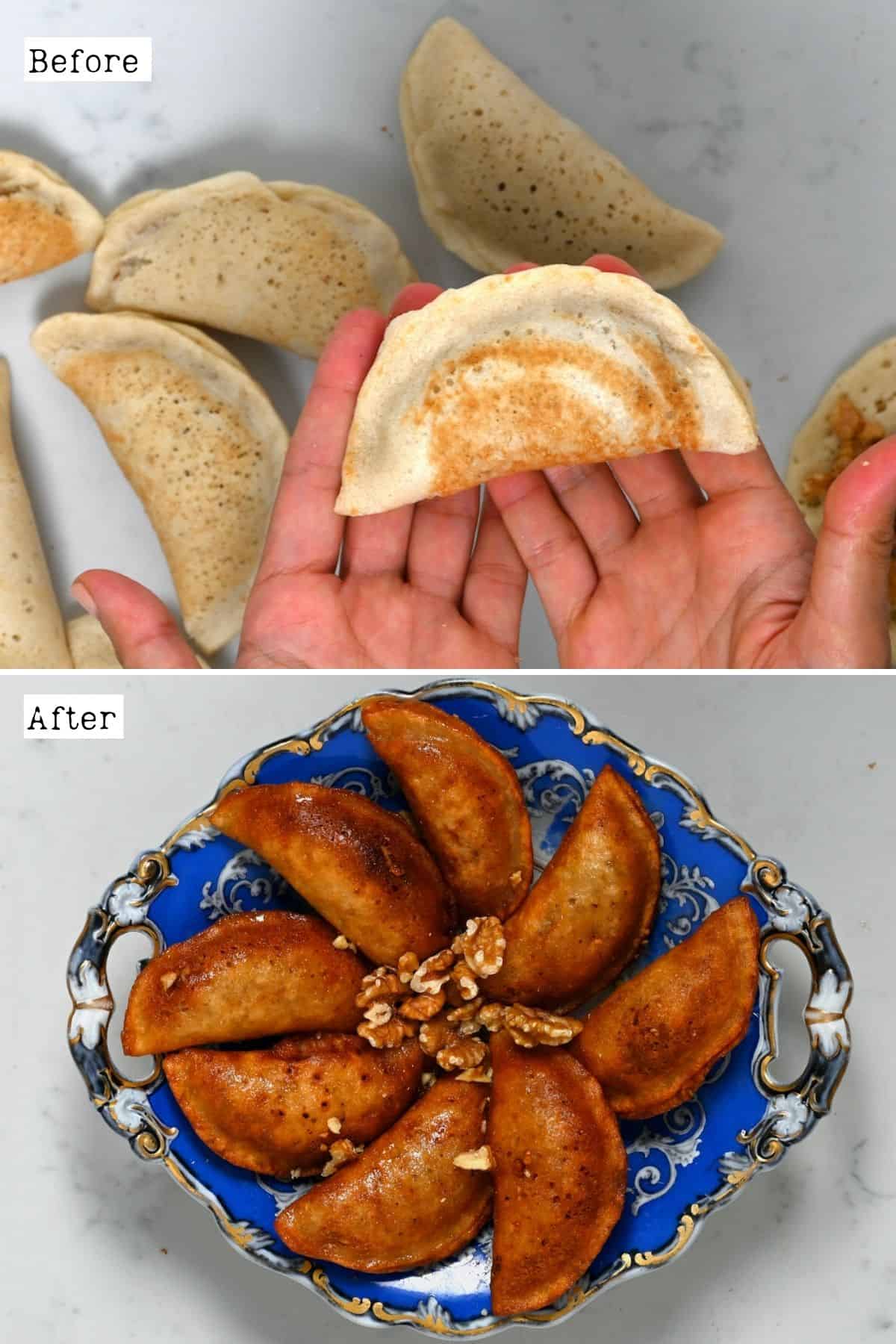
How to Make Ahead & Store
Make ahead: you can prepare and fill the qatayef in advance and freeze for up to 2 months (when using a nut filling, I haven’t tried with the ashta filling since it doesn’t freeze well in general). I recommend laying them (with space between) on a large baking tray and freezing until solid. Then transfer to a large Ziplock bag. When needed, you can fry the atayef from frozen (carefully) OR allow them to thaw in the fridge or at room temperature and enjoy!
You could also store the prepared pancakes and cream fillings (separately) in airtight bags/containers, ready to fill the following day.
Store: once prepared, the fried qatayef are best enjoyed within a few hours when they’re at their crispest. For the qatayef asafiri, you can store them covered in the refrigerator for 1-2 days.
Recipe Notes and Top Tips
- Experiment with the filling: this qatayef recipe batter works for sweet and savory fillings (like this spinach filling – possibly with some feta). Just reduce (or omit) the sugar when using it for savory purposes.
- If the pancakes don’t bubble: then it’s likely that your yeast has expired (either that or you used water that was too hot and killed the yeast). Check the best-before date and/or test it. It could also be because the batter is too thick – in which case, add a few tablespoons on water and try again (first check the yeast before adding extra liquid).
- Make sure to use the right yeast: if you don’t use instant yeast, then it first requires activating. I haven’t designed this recipe with that in mind, and haven’t tested a method that way.
- Make sure to cover the cooked pancakes: if you don’t, they’ll start to dry out before you get a chance to fill and shape them (which will become trickier). If this does happen, then you could try to use a finger damp with water to run along the edges to help them seal.
- Adjust the amount of syrup used: I don’t have an overly sweet tooth, so I usually just drizzle the qatayef lightly with it rather than dunk them entirely. I then serve them with extra syrup as dipping sauce, for those who prefer them sweeter.
- For larger atayef: you can use ¼ cup of the batter per pancake.
- To bake the atayef: this isn’t a method I’ve tested but a friend passed on to me. Brush the sealed filled pancaked with a little oil (or butter). Then arrange them on a baking sheet and bake in a pre-heated oven at 400ºF/200ºC until golden and crisp. To crisp up even further, you can broil them for a minute or two at the end.
Related Recipes and DIYs
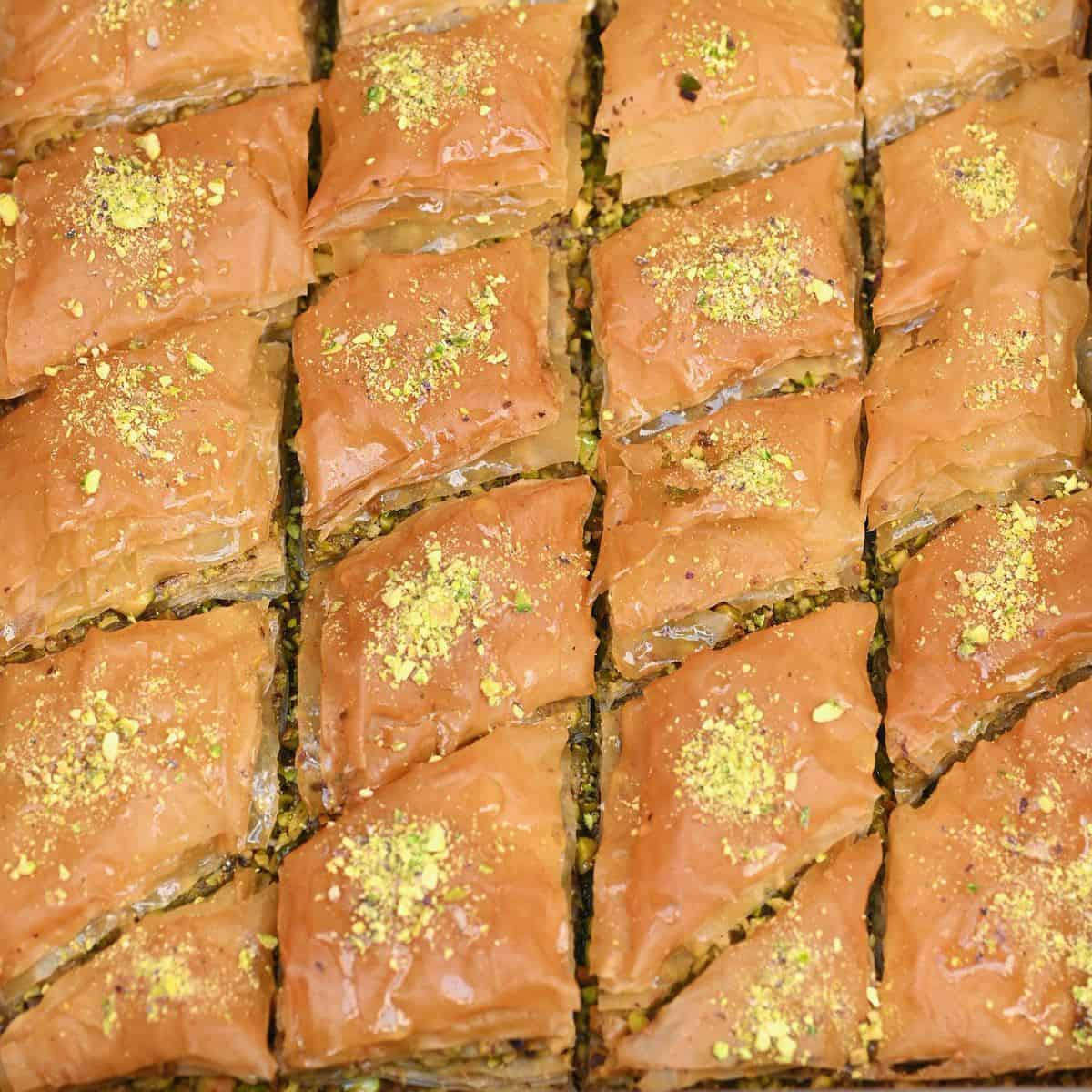
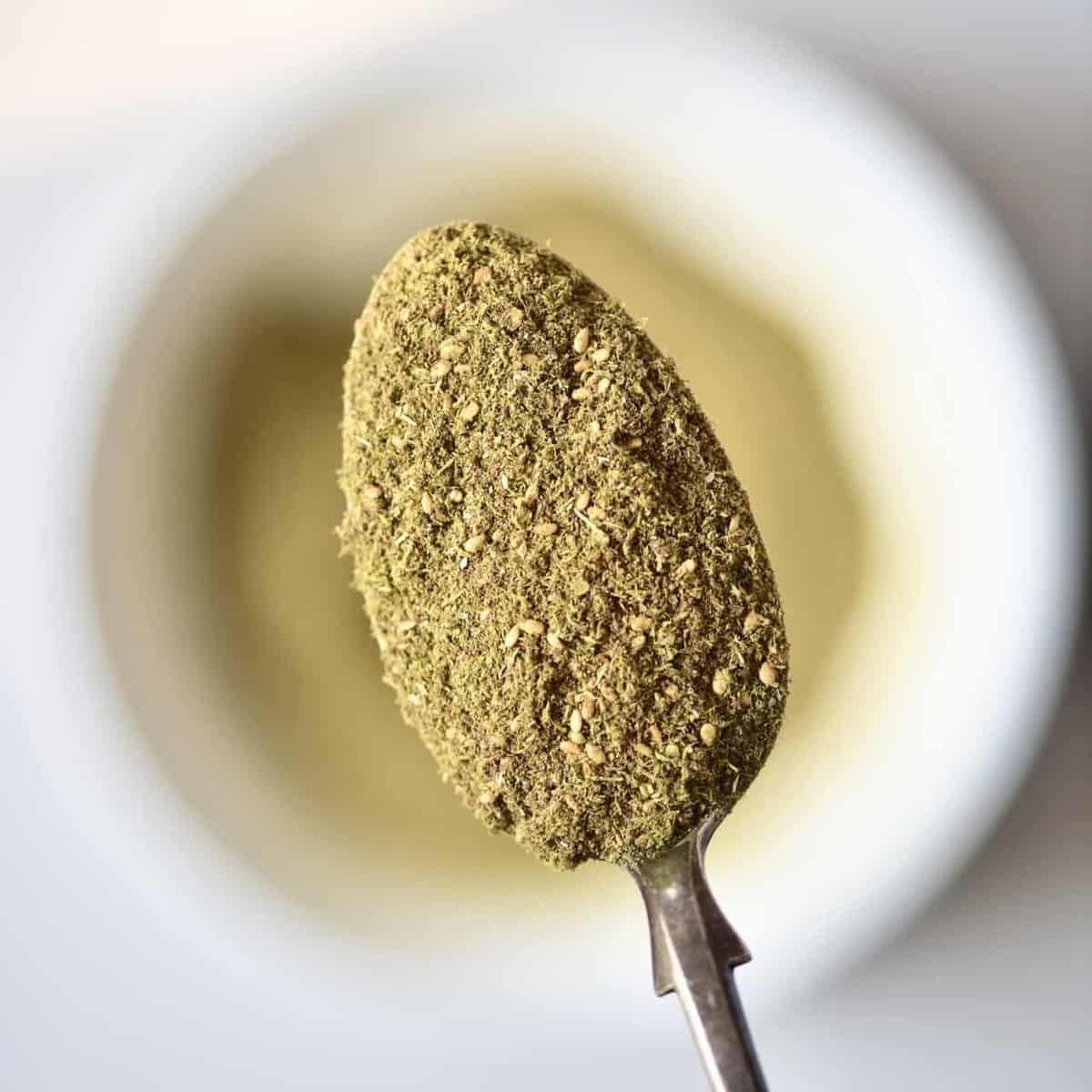
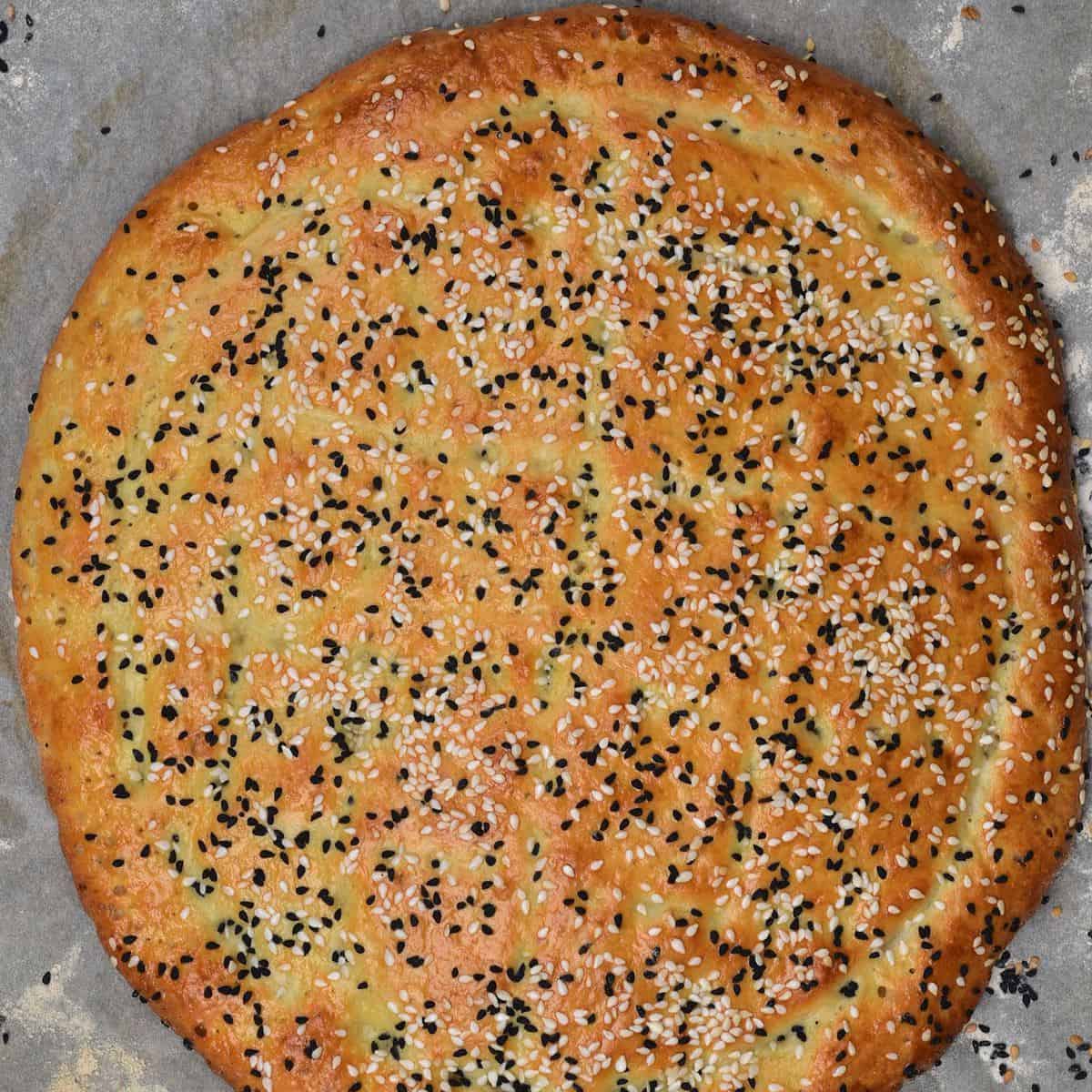
- Homemade pistachio baklava
- Middle Eastern za’atar bread
- Ramadan pide
- Homemade fig walnut jam
- Homemade pita chips
- Rose petal jam
- How to make date paste
- Maamoul Recipe (Middle Eastern Cookies with Dates or Nuts)
You might also enjoy browsing through my complete collection of Lebanese recipes!
If you try this Middle Eastern qatayef recipe, I’d love to hear your thoughts/questions below. Also, I’d appreciate a recipe card rating below, and feel free to tag me in your recipe recreations on Instagram @Alphafoodie!
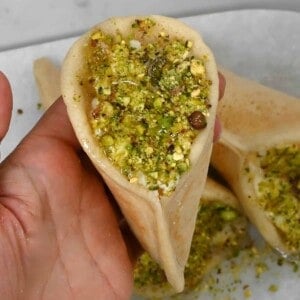
Qatayef Ashta (Lebanese Filled Pancakes | Ramadan Dessert)
Ingredients
For the dough:
- 10 oz all-purpose flour 2 cups
- 5.2 oz fine semolina 1 cup
- 0.3 oz powdered milk 2 Tbsp (or use 3/4 cup milk in place of some of the warm water)
- 3.5 cups water lukewarm
- 1 Tbsp sugar or sweetener
- 1 tsp dry yeast use INSTANT yeast
- 1 Tbsp baking powder
- ½ Tbsp mahlab powder optional
Fillings and toppings:
- 1.1 lb ashta
- 1 cup sugar syrup
- 3 Tbsp chopped pistachio for garnish
- vegetable oil for frying optional
Check the Recipe Notes below for optional add-ins/variations!
Instructions
- Ensure that your simple syrup and ashta filling are prepared in advance. For the syrup, use a 2:1 ratio of sugar to water with a splash of lemon juice. Simmer for around 8 minutes, until the syrup begins to thicken into a more ‘syrupy’ consistency.
Step 1: Prepare the Atayef Batter
- In a small bowl, combine the baking soda with ½ cup of lukewarm water and stir until the baking soda dissolves. Then set aside.
- Pour three cups of lukewarm water into a blender along with the remaining qatayef pancake ingredients (not the baking soda mixture). Blend well and then leave it to rest for 15 minutes (up to 45 minutes).
- Once rested, add the baking soda mixture, pulse a few times to mix (just for 4-5 seconds otherwise the batter will need to rest once more).
Step 2: Cook the "Pancakes"
- Heat a large non-stick skillet or griddle over medium heat until hot.
- Use around two tablespoons of batter (a small ice-cream/cookie scoop) per atayef and then add as many as possible to your skillet. While cooking, the pancakes will bubble up a lot (like crumpets). When the top of the pancake appears dry, it’s ready to remove them from the heat (no need to flip or it will dry out). If, in this time, the pancakes have burnt on the bottom, then simply reduce the heat slightly. Likewise, if they’re super pale on the bottom, increase the heat slightly (I recommend doing a test pancake first).Adjust the amount of batter used based on how big you want the atayef to be. Once cooked, place the qatayef (bubbly side up) on a plate under a clean towel (or plastic wrap) while you make the remainder of the pancakes. Don’t stack them up or they’ll stick.
- Repeat the above with the remaining batter, until you’ve used it all.
Step 3: Fill the Qatayef
- With the bubbly side up, fill each pancake center with 1-2 tablespoons of kashta (or the nut mixture). This will vary if you change the size of the pancakes. It needs to be enough to seal the pancake without it tearing.
- Then it’s time to seal the qatayef in one of two ways:Qatayef asafiri: Once filled, simply pinch the edges of the pancake together half-way, to form a cone shape, with the cream peaking out. Top up with a little extra ashta if preferred. Then either dip or sprinkle the exposed cream with the crushed pistachios and drizzle with the simple syrup – enjoy!Fried qatayef: Pinch the edges of the atayef together until fully sealed.
OPTIONAL Step 4: Fry the Qatayef
- In a wide, deep skillet, add enough oil to be around 1 ½-2 inches deep. Then, heat over medium heat until a chopstick/skewer dipped into the oil starts to form bubbles around it immediately (around 350ºF/175ºC if you have a thermometer).
- Then place a few of the qatayef in the oil at a time (you don’t want to pack the pan, or it will cause the oil to lose heat) and fry, flipping halfway, until a deep golden color (around two minutes).Adjust how golden/brown the qatayef are based on how crisp you want them to be.
- When removing the qatayef from the pan, transfer them to a layer of paper towels to drain any excess oil. Then, you can either drizzle the filled pancakes with the thick sugar syrup OR transfer them to a bowl with the syrup until thoroughly coated. After coating, transfer the filled pancakes to a rack with some parchment paper/foil beneath to drip off the excess syrup. Then, they’re ready to serve! You can optionally serve the qatayef with extra sugar syrup ‘dipping sauce’.
How to Make Ahead & Store
- Make ahead: you can prepare and fill the qatayef in advance and freeze for up to 2 months (when using a nut filling, I haven’t tried with the ashta filling, since it doesn’t freeze well in general). I recommend laying them (with space between) on a large baking tray and freezing until solid. Then transfer to a large Ziplock bag. When needed, you can fry the atayef from frozen (carefully) OR allow them to thaw in the fridge or at room temperature and enjoy!You could also store the prepared pancakes and cream fillings (separately) in airtight bags/containers, ready to fill the following day.Store: once prepared, the fried qatayef are best enjoyed within a few hours when they’re at their crispest. For the qatayef asafiri, you can store them, covered, in the refrigerator for 1-2 days.
Notes
- Experiment with the filling: this qatayef recipe batter works for sweet and savory fillings (like this spinach filling – possibly with some feta). Just reduce (or omit) the sugar when using it for savory purposes.
- If the pancakes don’t bubble: then it’s likely that your yeast has expired (either that or you used water that was too hot and killed the yeast). Check the best-before date and/or test it. It could also be because the batter is too thick – in which case, add a few tablespoons of water and try again (first check the yeast before adding extra liquid).
- Make sure to use the right yeast: if you don’t use instant yeast, then it first requires activating. I haven’t designed this recipe with that in mind, and haven’t tested a method that way.
- Make sure to cover the cooked pancakes: if you don’t, they’ll start to dry out before you get a chance to fill and shape them (which will become trickier). If this does happen, then you could try to use a finger damp with water to run along the edges to help them seal.
- Adjust the amount of syrup used: I don’t have an overly sweet tooth, so I usually just drizzle the qatayef lightly with it rather than dunk them entirely. I then serve them with extra syrup as a dipping sauce, for those who prefer them sweeter.tFor larger atayef: you can use ¼ cup of the batter per pancake.
- To bake the atayef: This isn’t a method I’ve tested but a friend passed on to me. Brush the sealed filled pancaked with a little oil (or butter). Then arrange them on a baking sheet and bake in a pre-heated oven at 400ºF/200ºC until golden and crisp. To crisp up even further, you can broil them for a minute or two at the end.
- Flavored ashta: the simplest way to add extra flavor to the qatayef recipe is with flavored ashta (or syrup). Check out this ashta recipe post for several options (vanilla, cocoa, etc.)
- Walnut filling: for a dairy-free filling, you can combine chopped walnuts (or another nut like hazelnuts, almonds, pistachios, etc.) with cinnamon (and optionally a tiny pinch of cardamom) and a little simple syrup lightly scented with rose water (or powdered sugar). Optionally you can add raisins too.
- Melty Cheese Filling: You could also use akawi cheese to fill the qatayef. Just make sure to soak it for several hours (3-4 at least) in ice-cold water first, to de-salt it. Drain/squeeze the water out before using.
- Coconut flakes: You can use coconut flakes to sprinkle the katayef instead of pistachios, for a nut-free treat (when making the atayef bil ashta).
Nutrition
Nutrition information is automatically calculated, so should only be used as an approximation.

